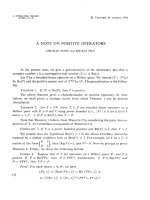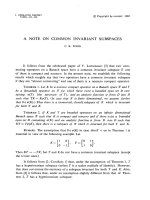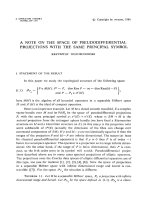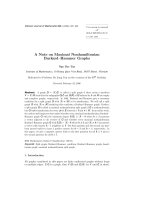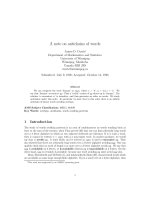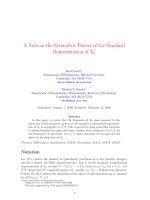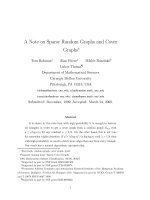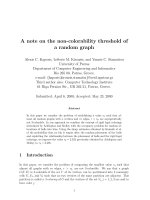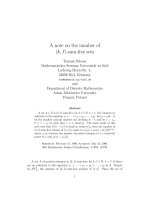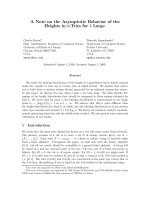Báo cáo toán học: "A Note on Sparse Random Graphs and Cover Graphs" docx
Bạn đang xem bản rút gọn của tài liệu. Xem và tải ngay bản đầy đủ của tài liệu tại đây (140.62 KB, 9 trang )
A Note on Sparse Random Graphs and Cover
Graphs
∗
Tom Bohman
†
Alan Frieze
‡
Mikl´os Ruszink´o
§
Lubos Thoma
¶
Department of Mathematical Sciences
Carnegie Mellon University
Pittsburgh, PA 15213, USA
,
,
Submitted: December, 1999; Accepted: March 24, 2000.
Abstract
It is shown in this note that with high probability it is enough to destroy
all triangles in order to get a cover graph from a random graph G
n,p
with
p ≤ κ log n/n for any constant κ<2/3. On the other hand, this is not true
for somewhat higher densities: If p ≥ λ(log n)
3
/(n log log n)withλ>1/8then
with high probability we need to delete more edges than one from every triangle.
Our result has a natural algorithmic interpretation.
∗
Keywords: random graph, cover graph, poset
Proposed running head: Sparse Cover Graphs
1991 Mathematics Subject Classification: 05C80, 06A07
†
Supported in part by NSF Grant DMS-9627408.
‡
Supported in part by NSF grant CCR-9530974.
§
Permanent Address Computer and Automation Research Institute of the Hungarian Academy
of Sciences, Budapest, P.O.Box 63, Hungary-1518. Supported in part by OTKA Grants T 030059
and T 29074 FKFP 0607/1999.
¶
Supported in part by NSF grant DMS-9970622.
1
the electronic journal of combinatorics 7 (2000), #R19 2
1 Cover Graphs
The (Hasse) diagram of the finite poset P =(V, ≺) is the directed graph
G =(V,A),
where (u, v) ∈ A iff u ≺ v and there is no z ∈ V such that u ≺ z ≺ v. The finite
undirected graph G =(V,E)isacover graph iff there exists an orientation of its
edges
E such that
G =(V,
E) is a diagram of some poset P =(V,≺). Clearly,
G =(V, A) is the diagram of a poset iff it contains no directed cycles and no directed
quasicycles. A directed quasicycle is a cycle with oriented edges in which the reversal
of the orientation of a single edge creates a directed cycle.
The relationship between cover graphs and graph parameters has been investigated
in several papers. B. Descartes [5] (as noted in [2]) showed that there are cover graphs
with arbitrarily large chromatic number and this was strenghtened by B. Bollob´as [2]
who showed that for every integer k there is a lattice whose diagram has chromatic
number at least k. Furthermore, it was proved by Neˇsetˇril and R¨odl [9] that there
exist graphs which are not cover graphs and have arbitrarily large girth.
The triangle is not a cover graph, since every orientation of its edges results in
either a directed cycle or quasicycle. However, after deleting an edge from it, we get a
path of length two, which is already a cover graph. Obviously, if we delete sufficiently
many edges from an arbitrary graph G it will become a cover graph. Therefore, it is
reasonable to ask, what is the minimum number c(G) such that after deleting c(G)
edges from G it will be a cover graph. This parameter was introduced by Bollob´as,
Brightwell, and Neˇsetˇril [4].
First consider dense random graphs. It is shown in [4] that for arbitrary integer
l ≥ 2andp = p(n)=o
n
(l−2)/(l−1)
, c(G
n,p
) ≤ (1 + δ)pn
2
/2l whp
1
.Moreover,if
p = p(n)=n
−1+η(n)
,where0<η
0
≤ η(n) ≤ 1, then whp one needs to delete a
positive proportion of edges from G
n,p
in order to get a cover graph. The auhors
of [4] also conjectured that if pn
(l−2)/(l−1)
→ 0andpn
(l−1)/l
→∞, then their upper
bound gives the right constant, i.e., whp c(G
n,p
) ∼ pn
2
/2l. This has been recently
proved by R¨odl and Thoma [10].
For sparse random graphs, the authors of [4] show that whp c(G
n,p
)=o(e(G
n,p
)).
Namely they prove the following two bounds. For every c ≥ 1thereisab, b >
c log(1 + b), such that if p = p(n) ≤
c log n
n
, then c(G
n,p
) ≤
pn
2
2
·
b
c log n
. Further, for
1
A sequence of events E
n
occurs with high probability, whp,ifPr(E
n
)=1− o(1) as n →∞
the electronic journal of combinatorics 7 (2000), #R19 3
every δ>0 and for every function ω = ω(n), with ω →∞and ω = o(n
ν
) for every
ν>0, if p = p(n) ≤
ω log n
n
, then c(G
n,p
) ≤ (1 + δ) ·
pn
2
2
·
log ω
log n
.
For a graph G let τ(G) denote the minimum number of edges that must be deleted
in order to get a triangle-free graph. In this note we focus on the graph property
c(G)=τ(G). Since a cover graph may contain no triangles τ(G) ≤ c(G)always
holds. We will show in this note, that for any constant κ<2/3andp ≤ κ log n/n,
c(G
n,p
)=τ(G
n,p
) whp (Theorem 1.1) while for any constant λ>1/8andp ≥
λ(log n)
3
/(n log log n),c(G
n,p
) >τ(G
n,p
) whp (Theorem 1.2).
We may interpret our results in an algorithmic way. Consider a simple algorithm
which takes a graph G as input and deletes edges in copies of triangles as long as G
is not triangle-free. Then Theorem 1.1 implies that if the algorithm takes as input
G
n,p
,p≤ κ log n/n for a constant κ<2/3, then it outputs a cover graph whp. Note
that the output graph will have whp girth equal to 4. On a related note we point to
[8] which surveys constructions of non cover graphs with a given girth. It is an open
problem to construct small examples of non cover graphs with girth greater then 4.
We will prove the following theorems:
Theorem 1.1 If κ<2/3 is constant and p ≤ κ log n/n then c(G)=τ(G) whp.
Theorem 1.2 If λ>1/8 is constant and p ≥ λ(log n)
3
/(n log log n) then c(G
n,p
) >
τ(G
n,p
) whp.
For p = c/n, c constant we know that the distribution of the number of triangles in
G
n,p
is asymptotically Poisson with mean c
3
/6, [6]. So as an immediate corollary we
get that if p = c
n
/n then
Corollary 1.3
lim
n→∞
Pr(G
n,p
is a cover graph)=
1 c
n
→−∞
e
−c
3
/6
c
n
→ c
0 c
n
→∞
Theorem 1.2 follows from the following stronger theorem:
Theorem 1.4 Suppose λ>1/8 is constant and p ≥ λ(log n)
3
/(n log log n) and g ≤
log n
4loglogn
.LetH be obtained from G
n,p
by deleting all vertices which lie on a cycle of
length at most g. Then whp H is not a cover graph.
the electronic journal of combinatorics 7 (2000), #R19 4
Remark 1.5 Part of the results of [10] is based on a detailed analysis of the expansion
properties of the random graph G
n,p
. Using the same analysis of the expansion
properties provides the same bound on p in Theorem 1.4.
2 Triangle-free graphs: proof of Theorem 1.1
We will need the following lemma. Let χ = χ(G) be the chromatic number of G.We
will call a cycle of G short if it contains ≤ χ(G) vertices and long otherwise. As usual
the distance between two sets V
1
and V
2
of vertices in G is the length of the shortest
path between u ∈ V
1
and v ∈ V
2
.
Lemma 2.1 Let G having the following properties:
(a) The distance between any two short cycles is at least χ +1.
(b) No short cycle shares an edge with a cycle of length ≤ 2χ.
Then c(G)=τ(G).
Proof Let G
=(V, E
) be a triangle-free subgraph of G which we get after
deleting one edge of each triangle of G.LetV
1
, ,V
χ
be a proper coloring of G
with χ colours. Define the orientation
G
=(V,
E
) as follows. If u ∈ V
i
, v ∈ V
j
and
i<jthen orient the edge {u, v} from u to v. Notice that
G
is acyclic, i.e., there are
no oriented cycles in
G
. Also there are no long oriented quasicycles. Indeed, take
an arbitrary long cycle C in G
.Letk =max{i : C ∩ V
i
= ∅} and let v ∈ C ∩ V
k
.
Both edges of C incident to v are oriented in
G
towards v. So in order to get an
oriented cycle we must change the orientation of at least one of the arcs (u
1
,v), (u
2
,v)
of C which are incident with v. Assume we get an oriented cycle by reversing the arc
(u
1
,v), say. Then the remaining edges of the cycle form an oriented path from u
1
to
v in
G
of length at least χ, a contradiction.
Of course, we still may have short oriented quasicycles. We will change the above
orientation as follows. If
G
contains no short quasicycles, then stop. If
G
contains a
short quasicycle
C then reverse an arc (u, v)in
C such that the resulting
C
is neither
a directed cycle, nor a directed quasicycle. (Since G
is triangle-free, we can always
do this.) Since G satisfies (a), i.e., in particular it contains vertex disjoint short cycles
the electronic journal of combinatorics 7 (2000), #R19 5
only, this process will terminate in at most n/χ steps and in the end there will be no
short quasicycles.
We show now that we have created neither long cycles nor long quasicycles. In-
deed, by (b), during the edge reversing process, we did not touch any long cycle
having ≤ 2χ vertices. So take a long cycle C having ≥ 2χ + 1 vertices. Let an edge
e ∈ C be short if it also lies on a short cycle and long otherwise. Long edges are
unaffected by the reversing process of the previous paragraph. Label each short edge
with the short cycle that produces it. Short edges with the same label form subpaths
of C. By (a) the distance between any two short edges of C with distinct labels is at
least χ and there will be two paths in C of length ≥ χ, made up long edges only. But
the longest oriented path in
G
is of length χ − 1. So if there are two short edges with
distinct labels then there are at least two long edges in
C in both directions along
the cycle. If the short edges of C all have the same label and they make up more
than one subpath then the paths of long edges in C between these subpaths are of
length at least χ, else (b) is violated. Hence, again, there are at least two long edges
in
C in both directions along the cycle. Finally, suppose that the short edges of C all
have the same label and they make up one subpath P . If none of the edges of P are
reversed then by its length C will have at least three edges oriented in each direction
around C. In any case, at most one will be reversed and so we will create neither a
directed cycle nor a directed quasicycle by the reversing process.
We complete the proof of Theorem 1.1 with
Lemma 2.2 If κ<2/3 is constant and p ≤ κ log n/n then G
n,p
whp satisfies the
conditions of Lemma 2.1.
Proof It follows from Luczak [7] that whp
χ(G
n,p
) ≤ k
0
=(
κ
2
+ o(1))
log n
log log n
.
Assuming this we see that if the conditions of Lemma 2.1 are violated then there
exists a set of k ≤ 3k
0
vertices which contain at least k + 1 edges. The probability of
the electronic journal of combinatorics 7 (2000), #R19 6
this is at most
3k
0
k=4
n
k
k
2
k +1
κ log n
n
k+1
≤
3k
0
k=4
ne
k
k
ke
2
·
κ log n
n
k+1
≤
eκ log n
2n
3k
0
k=4
k((e
2
κ/2) log n)
k
≤
3k
0
((e
2
κ/2) log n)
3k
0
+1
n
= o(1).
2.1 Sparse Non Cover Graphs: proof of Theorem 1.4
For positive integers a, b, a partition V
0
,V
1
, ,V
a
of an n-set is called an (a, b)-
partition if |V
0
| = b and |V
i
| = |V
j
| for all i = j; i, j ∈ [a]. Thus we can only have an
(a, b)-partition if a divides |V |−b.
We choose functions d = d(n),ω = ω(n), and N = N(n) such that
N = n − γ = n − o(n)
d
ω
ω
=2N log ω
d = ω
3
(log ω)
2
where γ is the smallest integer larger than gd
g
such that n − γ is divisible by ω. Note
that this choice implies ω =(1+o(1))
log n
2loglogn
and d =(1+o(1))
(log n)
3
8loglogn
.
Let p = d/n. Since the property in Theorem 1.4 is monotone decreasing it is
enough to prove Theorem 1.4 just for this choice of p.
We need the following lemma.
Lemma 2.3 Whp for every (ω,γ)-partition V
0
,V
1
, ,V
ω
of the vertex set of G
n,p
,
there is a cycle C in G
n,p
such that V (C) ∩ V
0
= ∅ and |V (C) ∩ V
i
| =1,i=1, ,ω.
Proof To prove the lemma we are going to use the Janson inequality, cf. [1] for
notation. Note that the number of choices of (ω,γ)-partitions of an n-set is at most
n
γ
(eω)
N
.
the electronic journal of combinatorics 7 (2000), #R19 7
Let V
0
,V
1
, ,V
ω
be a fixed (ω, γ)-partition. Let C
1
, ,C
l
be an enumeration of
cycles satisfying V (C
i
) ∩ V
0
= ∅ and |V (C
i
) ∩ V
j
| =1,i=1, ,l,j=1, ,ω,in the
complete graph K
n
with the partition V
0
,V
1
, ,V
ω
.SetB
i
,i =1, ,l, to be the
event that C
i
exists in G
n,p
. The expected number µ of such cycles in G
n,p
satisfies
µ =
l
j=1
Pr (B
j
)=(1+o(1))
N
ω
ω
d
N
ω
=(1+o(1))
d
ω
ω
=(1+o(1))2N log ω.
and
∆=
|E(C
i
)∩E(C
j
)|≥1
Pr (B
i
∧B
j
)
≤
t≥1
2≤L<ω
l
1
+···+l
t
=L
l
i
≥2
(1 + o(1))ω
t
N
ω
L
N
ω
2ω−2L
d
N
2ω−(L−t)
(1)
=(1+o(1))µ ·
t,L
l
1
, ,l
t
d
ω
ω
ω
L+t
d
L−t
N
t
≤ (1 + o(1))µ ·
t,L
L − 1
t − 1
2N log ω ·
ω
d
L
ωd
N
t
=(1+o(1))µ ·
2≤L<ω
2N log ω ·
ω
d
L
ωd
N
1+
ωd
N
L−1
= o(µ) .
Note that the dominant term in the last sum is the term for L =2.
Explanation of (1): The common edges of cycles C
i
,C
j
are asumed to form t
paths of lengths l
1
,l
2
, ,l
t
. ω
t
estimates the number of choices for the start vertices
of these paths. (N/ω)
L
estimates the choices for the vertices of these paths and
(N/ω)
2ω−2L
estimates the choices for the vertices in C
i
,C
j
which are not on any
common path. (d/N)
2ω−(L−t)
is the probability that C
i
,C
j
exist.
Applying the Janson inequality we see that
Pr(∃ an (ω, γ)-partition without a cycle) ≤
n
γ
(eω)
N
e
−(1−o(1))µ
≤
n
n
3/4
ω
−(1−o(1))N
= o(1).
We can assume g =
log n
4loglogn
and that the condition in Lemma 2.3 holds. Now
the electronic journal of combinatorics 7 (2000), #R19 8
the expected number of vertices ν on cycles of length g or less in G
n,p
is given by
g
k=3
n
k
(k − 1)!p
k
≤ d
g
g
k=3
1
k
≤ d
g
log g.
So whp ν ≤ gd
g
.
Let
ˆ
V
0
be the set of vertices of G incident to cycles of length g or less and V
0
⊇
ˆ
V
0
be arbitrarily chosen of size γ.ThenG
:= G \ V
0
is not a cover graph. Suppose it
is. Let
−→
G
be its orientation as a diagram of some poset. Thus, we can embed
−→
G
into a linear ordering π.LetV
1
, ,V
ω
, |V
i
| = N/ω, be the partition of the vertex
set of G
such that all vertices of V
i
precede all vertices of V
i+1
in the linear ordering
π, i =1, ,ω − 1. We have constructed an (ω, γ)-partition V
0
,V
1
, ,V
ω
of the
vertex set of G. By the lemma above we can assume that there is a cycle C such that
V (C) ∩ V
0
= ∅ and |V (C) ∩ V
i
| =1,i=1, ,ω. The cycle C induces a quasicycle in
−→
G
– contradiction. This completes the proof of Theorem 1.4.
References
[1] N. Alon, J. Spencer, The Probabilistic Method, John Wiley & Sons Inc., New
York, 1992.
[2] B. Bollob´as, Colouring lattices, Alg. Universalis 7 (1977), 313–314.
[3] B. Bollob´as, Random Graphs, Academic Press 1985.
[4] B. Bollob´as, G. Brightwell and J. Neˇsetˇril, Random Graphs and Covering Graphs
of Posets, Order 3 (1986) 245–255.
[5] B. Descartes, A Three Color Problem, Eureka, April 1947. Solution March 1948.
[6] P.Erd˝os and A.R´enyi, On the evolution of random graphs, Publ. Math. Inst.
Hungar. Acad. Sci. 5 (1960) 17-61.
[7] T.Luczak, The chromatic number of random graphs, Combinatorica 11 (1991)
45-54.
the electronic journal of combinatorics 7 (2000), #R19 9
[8] O. Pretzel, Orientations and Edge Functions on Graphs, in: A.D.Keedwell
(ed.), Surveys in Combinatorics, London Math. Soc. Lecture Notes 66, 1991,
161–185.
[9] J. Neˇsetˇril and V. R¨odl, On a Probabilistic Graph-Theoretical Method, Proceed-
ings AMS 72(2) (1978), 417–421.
[10] V. R¨odl, L. Thoma, On Cover Graphs and Dependent Arcs in Acyclic Orienta-
tions, submitted.
